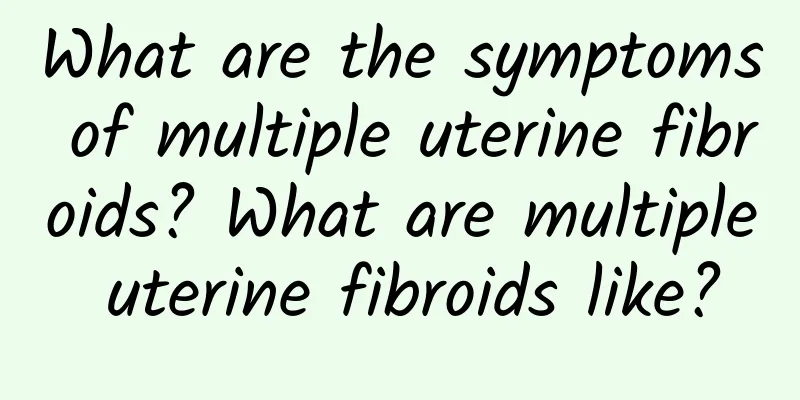What are the symptoms of multiple uterine fibroids? What are multiple uterine fibroids like?

|
The symptoms of multiple uterine fibroids in the early stage are not obvious, and some women usually have no symptoms in the early stage, which is often very unfavorable to the development of the disease. Therefore, experts remind female friends that the key is to understand the symptoms of multiple uterine fibroids as soon as possible in order to better prevent and control the disease. The symptoms of multiple uterine fibroids are usually different for each person, mainly related to the size, location and growth rate of the fibroids. The common clinical symptoms of multiple uterine fibroids are mainly the following: 1. Menstrual changes: This is a very common symptom, which is usually prone to menorrhagia, prolonged menstruation, and even irregular vaginal bleeding. Submucosal fibroids usually cause menorrhagia, and as the fibroids grow larger, the menstruation becomes longer. Once the fibroids become necrotic, ulcerated, or infected, there will be persistent or irregular vaginal bleeding or purulent expansion fluid. Subserosal fibroids and intramural small fibroids often do not have obvious menstrual changes. 2. Abdominal mass: Patients with uterine fibroids are prone to symptoms of abdominal mass, which is easier to touch in the morning when the bladder is full. It is hard in texture and irregular in shape. 3. Bleeding: Submucosal fascia and myoma increase the area of uterine cavity and increase menstrual volume. 4. Abdominal pain, backache, lower abdominal swelling: Patients usually have no abdominal pain, but acute abdominal pain occurs when the pedicle of the subserosal fibroid is twisted. When the fibroid is red, the abdominal pain is severe, accompanied by fever. Lower abdominal swelling and back pain are common, and menstruation is aggravated. 5. Compression symptoms: Myoma compresses the bladder, causing frequent urination, urinary dysfunction, urinary retention, etc. Compression of the ureter can cause hydronephrosis, and compression of the rectum can cause difficulty in defecation. 6. Infertility: According to literature reports, it accounts for 25% to 40%. It may be that the fibroids compress the fallopian tubes and deform the uterine cavity, hindering the implantation of the fertilized egg. 7. Secondary anemia: Long-term menorrhagia leads to secondary anemia. In severe cases, symptoms include general fatigue, pale complexion, shortness of breath, palpitations, etc. In addition, increased vaginal discharge is also a more common symptom of multiple uterine fibroids. Of course, many gynecological diseases will cause increased vaginal discharge, so it is inaccurate to judge uterine fibroids only by abnormal vaginal discharge. We must choose regular hospital diagnosis is the most important. |
Recommend
How much does hysteroscopic abortion cost?
Nowadays, people are becoming more and more open-...
How long does it take to completely cure endometrial tuberculosis?
How long does it take to completely cure endometr...
What you need to know about Gua Sha: It can help you get rid of local obesity
We often hear people say, "I have heatstroke...
Winter melon is a treasure from head to toe. It helps you lose weight and beautify your skin.
Winter melon has been a good weight loss product ...
Can mild adnexitis heal on its own?
Can mild adnexitis heal itself? Experts suggest t...
Is the cure rate for incomplete abortion high?
Some women get pregnant unexpectedly without taki...
What are the symptoms of uterine fibroids? Will uterine fibroids cause long-term infertility?
What are the symptoms of uterine fibroids? With t...
What are the tests for menopause?
What are the examinations for menopause? Menopaus...
How to diagnose pelvic inflammatory disease accurately
How to diagnose pelvic inflammatory disease accur...
Cervical hypertrophy can be checked by vaginal ultrasound
Cervical hypertrophy can be diagnosed by vaginal ...
How to treat vulvar leukoplakia
Vulvar leukoplakia is a common gynecological dise...
How to do daily care for cervical erosion
Cervical erosion is a phenomenon of chronic cervi...
Can cervical erosion develop into cervical cancer?
"Cervical erosion" troubles many female...
The clinical manifestations of irregular menstruation are mainly reflected in the following aspects
Irregular menstruation has been bothering women f...
Hospitals with good results in treating threatened abortion in China
Everyone hopes to be able to choose a suitable ho...









